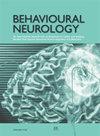自闭症谱系障碍和癫痫伴功能障碍的共同病因
IF 2.3
4区 医学
Q2 CLINICAL NEUROLOGY
引用次数: 6
摘要
自闭症谱系障碍和癫痫是异质的人类疾病,具有多种病因和病理生理学。自闭症患者有相当大的频繁癫痫的风险,这促进了发病率和死亡率的增加。几种生物学途径似乎与疾病进展有关,包括基因转录调控、细胞生长、突触通道功能和突触结构的维持。本研究回顾了兴奋性/抑制性(E/I)平衡比异常以及部分癫痫样活动,这些活动可能导致过度连接和遗传性疾病,其中自闭症谱系障碍和癫痫经常同时发生。本文讨论了自闭症谱系障碍和癫痫共同发生的常见病因和分子机制,以及保护患者认知和行为的强有力的药物治疗方法。更好的了解是必要的,以确定可能导致这些神经系统疾病的可能治疗的生物学机制。本文章由计算机程序翻译,如有差异,请以英文原文为准。
Shared Etiology in Autism Spectrum Disorder and Epilepsy with Functional Disability
Autism spectrum disorders and epilepsies are heterogeneous human disorders that have miscellaneous etiologies and pathophysiology. There is considerable risk of frequent epilepsy in autism that facilitates amplified morbidity and mortality. Several biological pathways appear to be involved in disease progression, including gene transcription regulation, cellular growth, synaptic channel function, and maintenance of synaptic structure. Here, abnormalities in excitatory/inhibitory (E/I) balance ratio are reviewed along with part of an epileptiform activity that may drive both overconnectivity and genetic disorders where autism spectrum disorders and epilepsy frequently co-occur. The most current ideas concerning common etiological and molecular mechanisms for co-occurrence of both autism spectrum disorders and epilepsy are discussed along with the powerful pharmacological therapies that protect the cognition and behavior of patients. Better understanding is necessary to identify a biological mechanism that might lead to possible treatments for these neurological disorders.
求助全文
通过发布文献求助,成功后即可免费获取论文全文。
去求助
来源期刊

Behavioural Neurology
医学-临床神经学
CiteScore
5.40
自引率
3.60%
发文量
52
审稿时长
>12 weeks
期刊介绍:
Behavioural Neurology is a peer-reviewed, Open Access journal which publishes original research articles, review articles and clinical studies based on various diseases and syndromes in behavioural neurology. The aim of the journal is to provide a platform for researchers and clinicians working in various fields of neurology including cognitive neuroscience, neuropsychology and neuropsychiatry.
Topics of interest include:
ADHD
Aphasia
Autism
Alzheimer’s Disease
Behavioural Disorders
Dementia
Epilepsy
Multiple Sclerosis
Parkinson’s Disease
Psychosis
Stroke
Traumatic brain injury.
 求助内容:
求助内容: 应助结果提醒方式:
应助结果提醒方式:


